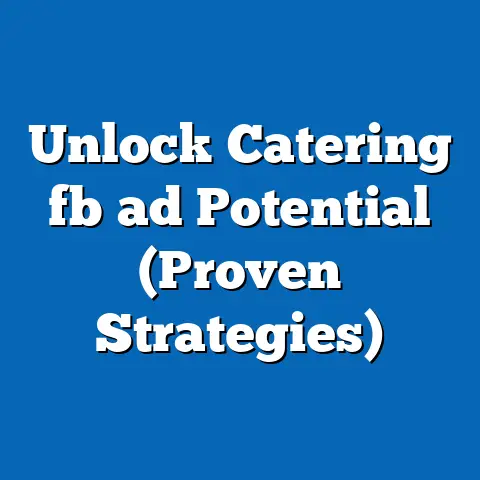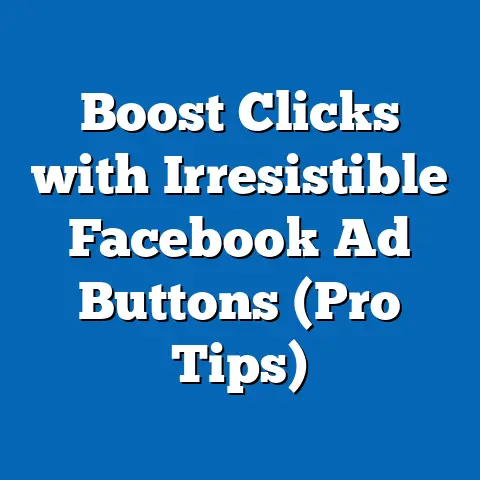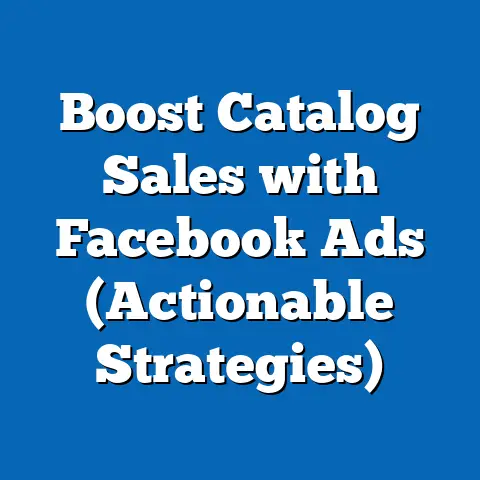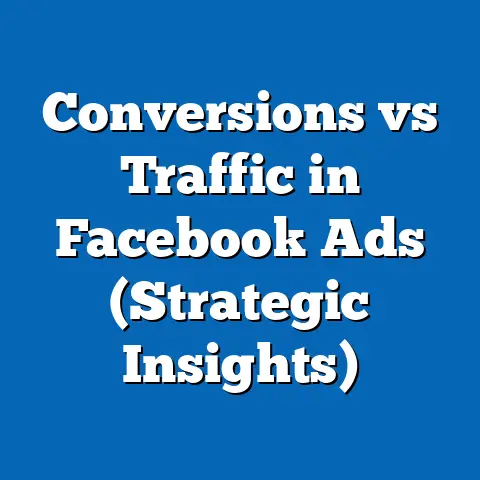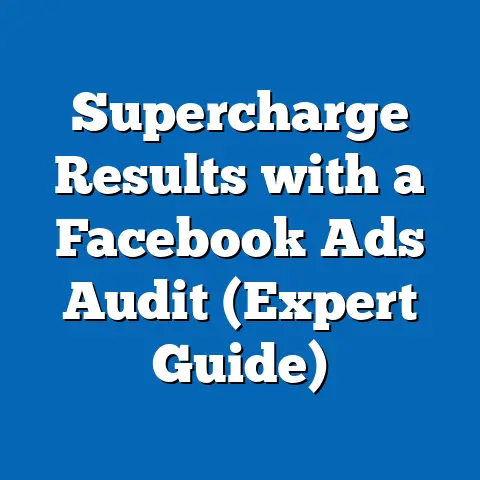Maximize Claim Credit with Facebook Ads (Pro Secrets)
In the ever-evolving world of digital marketing, endurance is the name of the game. It’s not about chasing fleeting trends or relying on one-hit wonders; it’s about building sustainable strategies that stand the test of time. This is especially true when it comes to Facebook Ads. I’ve seen countless businesses dive headfirst into Facebook advertising, expecting instant results and overnight success. However, the reality is that successful campaigns require persistence, adaptability, and a long-term vision.
While many businesses seek quick wins, the true power of Facebook Ads lies in the ability to build and optimize over time. It’s about understanding your audience, refining your messaging, and constantly tweaking your approach based on data and insights. Maximizing claim credit through Facebook Ads is not just about immediate results; it’s about creating sustainable strategies that yield long-term benefits. It’s about planting seeds today that blossom into a thriving garden of loyal customers tomorrow. This guide isn’t a magic bullet, but a roadmap to help you navigate the intricacies of Facebook advertising and unlock its full potential.
Understanding Claim Credit
What exactly is “claim credit” in the context of Facebook Ads? Essentially, it’s about accurately attributing conversions and customer engagement to your advertising efforts. It’s about knowing which ads, which campaigns, and which targeting strategies are truly driving results. Without a clear understanding of claim credit, you’re essentially flying blind, wasting valuable resources on ads that aren’t performing.
Claim credit is directly related to tracking conversions and customer engagement. It’s about tracing the customer journey from the moment they first see your ad to the point where they make a purchase, sign up for a newsletter, or take any other desired action. The better you understand this journey, the more effectively you can attribute value to your Facebook Ads.
For example, imagine a customer who sees your Facebook Ad for a new pair of running shoes. They click on the ad, browse your website, but don’t make a purchase. A few days later, they receive an email from you with a special discount code. They click on the link in the email and finally make the purchase. Which marketing channel deserves the credit for that sale? Was it the Facebook Ad that initially sparked their interest, or the email that sealed the deal? Claim credit helps you answer these questions and accurately attribute value to each touchpoint.
Understanding the customer journey is crucial for maximizing claim credit. Facebook Ads often play a role in the early stages of the marketing funnel, raising awareness and generating interest. However, they may not be the sole driver of conversions. That’s why it’s important to consider how Facebook Ads fit into the broader marketing funnel, alongside other channels like email marketing, content marketing, and SEO.
Attribution models play a key role in determining how credit is assigned to different touchpoints along the customer journey. Facebook offers several different attribution models, each with its own strengths and weaknesses. Some of the most common attribution models include:
- Last-click attribution: This model assigns all the credit to the last click the customer made before converting. In the running shoes example, the email would receive all the credit.
- First-click attribution: This model assigns all the credit to the first click the customer made. In the running shoes example, the Facebook Ad would receive all the credit.
- Linear attribution: This model distributes the credit evenly across all the touchpoints. In the running shoes example, both the Facebook Ad and the email would receive 50% of the credit.
- Time-decay attribution: This model assigns more credit to the touchpoints that occurred closer to the conversion. In the running shoes example, the email would receive more credit than the Facebook Ad.
- Data-driven attribution: This model uses machine learning to analyze the data and determine the optimal way to assign credit to each touchpoint. This is often the most accurate model, but it requires a significant amount of data to work effectively.
Choosing the right attribution model is crucial for accurately measuring the performance of your Facebook Ads. I’ve found that data-driven attribution is often the most effective, but it’s important to experiment with different models and see what works best for your business.
Takeaway: Understanding claim credit is about accurately attributing conversions and customer engagement to your Facebook advertising efforts. By considering the customer journey, utilizing appropriate attribution models, and tracking your results, you can optimize your campaigns for maximum impact.
Setting Up Your Facebook Ads for Success
Now that we understand the importance of claim credit, let’s dive into the practical steps you can take to set up your Facebook Ads for success. This involves careful planning, precise targeting, compelling creative, and robust conversion tracking.
First and foremost, audience targeting is paramount. You can’t expect to maximize claim credit if you’re showing your ads to the wrong people. Facebook offers a wide range of targeting options, allowing you to reach specific demographics, interests, behaviors, and even custom audiences.
- Demographics: Target users based on age, gender, location, education, and other demographic factors.
- Interests: Target users based on their interests, hobbies, and passions.
- Behaviors: Target users based on their online behavior, such as purchase history, website visits, and app usage.
- Custom Audiences: Create custom audiences based on your existing customer data, such as email lists, website visitors, and app users.
I’ve found that custom audiences are particularly effective for maximizing claim credit. By targeting your existing customers, you can re-engage them with relevant ads and drive repeat purchases. You can also create lookalike audiences based on your custom audiences, expanding your reach to new users who share similar characteristics.
Next, ad creative plays a crucial role in capturing attention and driving conversions. Your ads need to be visually appealing, engaging, and relevant to your target audience. Consider the following elements:
- Visuals: Use high-quality images or videos that grab attention and communicate your message effectively.
- Copy: Write clear, concise, and compelling copy that highlights the benefits of your product or service.
- Calls-to-action: Include strong calls-to-action that encourage users to take the desired action, such as “Shop Now,” “Learn More,” or “Sign Up.”
I’ve learned that A/B testing different ad creatives is crucial for identifying what resonates best with your audience. Experiment with different visuals, headlines, and calls-to-action to see what drives the highest conversion rates.
Finally, clear conversion tracking is essential for accurately measuring the performance of your Facebook Ads. This involves setting up the Facebook Pixel, creating custom conversions, and utilizing UTM parameters for better tracking.
- Facebook Pixel: Install the Facebook Pixel on your website to track user behavior and measure conversions.
- Custom Conversions: Create custom conversions to track specific actions on your website, such as purchases, sign-ups, or form submissions.
- UTM Parameters: Use UTM parameters to track the source of your traffic and attribute conversions to specific campaigns and ads.
By setting up these tracking mechanisms, you can gain valuable insights into how your Facebook Ads are performing and make data-driven decisions to optimize your campaigns.
Takeaway: Setting up your Facebook Ads for success involves careful planning, precise targeting, compelling creative, and robust conversion tracking. By focusing on these key elements, you can maximize claim credit and drive meaningful results.
Leveraging Facebook’s Tools and Features
Facebook offers a plethora of tools and features that can help you maximize claim credit and improve your advertising performance. It’s not just about setting up basic ads; it’s about leveraging the platform’s advanced capabilities to reach the right audience with the right message at the right time.
Dynamic ads are a powerful way to retarget users who have previously interacted with your website or app. These ads automatically display products or services that users have viewed, added to their cart, or shown interest in. By reminding users of what they were looking at, you can increase the likelihood of a conversion.
I’ve seen firsthand how effective dynamic ads can be, especially for e-commerce businesses. For example, if a user browses a specific product on your website but doesn’t make a purchase, you can show them a dynamic ad featuring that product, along with a special discount or promotion. This can be a highly effective way to nudge them towards completing the purchase.
A/B testing is another crucial tool for optimizing your Facebook Ads. By testing different variations of your ads, you can identify what resonates best with your audience and improve your performance. You can test different visuals, headlines, calls-to-action, and even targeting options.
Facebook’s A/B testing feature makes it easy to create and run experiments. Simply create two or more variations of your ad and let Facebook automatically split your audience and show each variation to a different group of users. After a certain period, you can analyze the results and see which variation performed best.
Lookalike audiences are a fantastic way to expand your reach and find new customers who share similar characteristics with your existing high-value customers. Facebook uses its vast database of user data to identify users who are similar to your best customers based on demographics, interests, and behaviors.
To create a lookalike audience, you need to provide Facebook with a source audience, such as your email list, website visitors, or app users. Facebook will then analyze this source audience and create a lookalike audience that shares similar characteristics. I’ve found that lookalike audiences can be a highly effective way to find new customers who are likely to be interested in your products or services.
Takeaway: Facebook offers a range of advanced tools and features that can help you maximize claim credit and improve your advertising performance. By leveraging dynamic ads, A/B testing, and lookalike audiences, you can reach the right audience with the right message and drive meaningful results.
Analyzing and Optimizing Performance
Setting up your Facebook Ads is only half the battle. The real magic happens when you start analyzing your performance and making data-driven decisions to optimize your campaigns. Regularly monitoring your metrics is crucial for identifying what’s working, what’s not, and where you can make improvements.
Key performance indicators (KPIs) are essential for measuring the success of your Facebook Ads. Here are some of the most relevant KPIs for claim credit:
- Conversion Rate: The percentage of users who take the desired action after clicking on your ad, such as making a purchase or signing up for a newsletter.
- Cost Per Acquisition (CPA): The cost of acquiring a new customer through your Facebook Ads.
- Return on Ad Spend (ROAS): The amount of revenue generated for every dollar spent on your Facebook Ads.
- Click-Through Rate (CTR): The percentage of users who click on your ad after seeing it.
- Cost Per Click (CPC): The cost of each click on your ad.
- Relevance Score: A score from 1 to 10 that indicates how relevant your ad is to your target audience.
By tracking these KPIs, you can gain valuable insights into how your Facebook Ads are performing and identify areas for improvement. Facebook Ads Manager provides a wealth of data and reporting tools that can help you analyze your performance.
Interpreting data from Facebook Ads Manager can be overwhelming at first, but it’s important to focus on the metrics that are most relevant to your goals. For example, if your goal is to drive sales, you should focus on conversion rate, CPA, and ROAS. If your goal is to increase brand awareness, you should focus on reach, impressions, and engagement.
Once you’ve analyzed your data, you can start making data-driven decisions to optimize your campaigns. This might involve adjusting your budgets, refining your targeting, or updating your creative elements.
Here are some tactics for ongoing optimization:
- Adjust Budgets: Increase your budget for campaigns that are performing well and decrease your budget for campaigns that are not.
- Refine Targeting: Experiment with different targeting options to see what works best for your audience.
- Update Creative: Regularly update your ad creative to keep it fresh and engaging.
- A/B Test: Continuously A/B test different variations of your ads to identify what resonates best with your audience.
- Monitor Relevance Score: Keep an eye on your relevance score and make adjustments to your targeting or creative if it starts to decline.
I’ve found that ongoing optimization is crucial for maximizing the performance of your Facebook Ads. It’s not a one-time task; it’s a continuous process of analyzing, testing, and refining your campaigns based on data and insights.
Takeaway: Analyzing and optimizing performance is crucial for maximizing claim credit and improving your advertising results. By tracking key performance indicators, interpreting data from Facebook Ads Manager, and making data-driven decisions, you can continuously refine your campaigns and drive meaningful results.
Case Studies and Real-Life Examples
To illustrate how businesses can successfully maximize claim credit using Facebook Ads, let’s take a look at a few case studies and real-life examples. These examples highlight the strategies employed, the challenges faced, and the results achieved.
Case Study 1: E-commerce Business
An e-commerce business selling handmade jewelry wanted to increase sales and improve their ROAS. They implemented a Facebook Ads strategy that focused on retargeting website visitors with dynamic ads. They also created lookalike audiences based on their existing customers and targeted them with ads featuring their best-selling products.
The results were impressive. Their conversion rate increased by 30%, their CPA decreased by 20%, and their ROAS increased by 50%. They were able to attribute a significant portion of their sales to their Facebook Ads, demonstrating the power of retargeting and lookalike audiences.
Case Study 2: Local Restaurant
A local restaurant wanted to attract more customers and increase reservations. They implemented a Facebook Ads strategy that focused on targeting local residents with ads featuring their daily specials and promotions. They also created a custom audience based on their email list and targeted them with exclusive offers.
Their efforts paid off. Their website traffic increased by 40%, their online reservations increased by 25%, and their overall sales increased by 15%. They were able to attribute a significant portion of their new customers to their Facebook Ads, demonstrating the effectiveness of local targeting and email marketing integration.
Case Study 3: SaaS Company
A SaaS company wanted to generate more leads and increase sign-ups for their software platform. They implemented a Facebook Ads strategy that focused on targeting professionals in their industry with ads featuring their software’s key benefits and features. They also created a lead generation form directly within their Facebook Ads, making it easy for users to sign up for a free trial.
Their results were outstanding. Their lead generation rate increased by 60%, their sign-up rate increased by 40%, and their overall customer acquisition cost decreased by 30%. They were able to attribute a significant portion of their new customers to their Facebook Ads, demonstrating the power of lead generation ads and targeted messaging.
These case studies demonstrate that maximizing claim credit with Facebook Ads is possible with the right strategy and execution. By focusing on targeting, creative, tracking, and optimization, businesses can achieve meaningful results and drive significant growth.
Takeaway: Case studies and real-life examples illustrate how businesses can successfully maximize claim credit using Facebook Ads. By learning from these examples and applying similar strategies to your campaigns, you can achieve your desired results and drive meaningful growth.
Conclusion
In conclusion, maximizing claim credit through Facebook Ads is not a sprint, but a marathon. It requires endurance, persistence, and a long-term vision. It’s about understanding your audience, refining your messaging, and constantly tweaking your approach based on data and insights.
I’ve seen too many businesses get discouraged when they don’t see instant results from their Facebook Ads. But the truth is that successful campaigns take time to build and optimize. It’s about learning from your mistakes, adapting to changes in the marketplace, and continuously improving your strategy.
Remember that Facebook Ads are just one piece of the puzzle. They need to be integrated with your overall marketing strategy, working in synergy with other channels like email marketing, content marketing, and SEO.
By implementing the strategies outlined in this article and remaining persistent in your efforts, you can achieve long-term success and meaningful engagement with your audience. It’s about planting seeds today that blossom into a thriving garden of loyal customers tomorrow. So, embrace the journey, stay focused on your goals, and never stop learning and optimizing. The rewards are well worth the effort.

